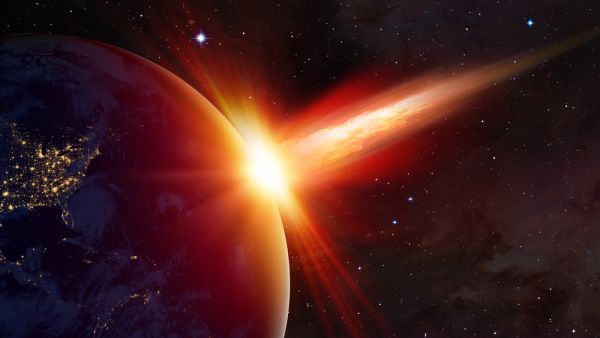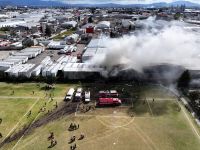Rock samples taken from under the Chicxulub crater left by the dinosaur-killing asteroid 66 million years ago could hold the key to the origin of life on Earth.
A team of researchers found that the impact of the city-sized space rock produced a network of warm waterways under the crater, which is in the Yucatán Peninsula in Mexico.
This hydrothermal network provides the perfect conditions for micro-organisms to thrive, suggesting a similar asteroid impact billions of years earlier may have kickstarted life on our planet.
This process could even hold the key to finding life on Mars or rocky exoplanets outside our solar system, according to lead author Dr David Kring.
The hydrothermal network under the Chicxulub crater lasted more than a million years, and fuelled production of chemicals and proteins that make up living cells, according to the researchers.
The study was carried out by an international team from the Universities Space Research Association, Imperial College London and the universities of Edinburgh and Glasgow.
It backs up a theory that our once barren planet was seeded with life by meteorites that crash-landed and leached essential elements into hot springs.
Basic building blocks in the nutrient-rich broth bonded into self-replicating bits of DNA called RNA molecules - turning into the genetic code for life.
Study authors say the same findings would apply to any rocky world in the habitable zone - and even some on the edge, like Mars.
'It demonstrates impact cratering is a fundamentally important heat engine in emerging planetary systems,' the scientists said.
'The geologically young Chicxulub crater is a suitable analogue for terrestrial impact basins created almost four billion years ago.
'Impact-generated hydrothermal systems were prominent features on early Earth and wherever water exists in a planetary crust.'
Today, Yellowstone in the US has the largest and most varied collection of hydrothermal features on Earth including geysers, hot springs, mud pots and fumaroles - they bubble, gurgle, hiss and spout throughout the area.
This same activity as seen in Yellowstone would have been happening on a much wider scale in the aftermath of the extinction event.
'This hydrothermal system may have persisted for more than 100,000 years, permanently altering the chemical and mineralogical makeup of a large region of Earth's crust,' Kring said.
A previous expedition to the crater uncovered hydrothermal changes 328ft thick.
The latest study published in Science Advances suggests hot fluid circulated at least 2,300ft below the surface of the crater site.
This supports the hypothesis large meteor impacts earlier in Earth's history produced hydrothermal clays that catalysed RNA synthesis - sparking the origin of life on Earth.
Mineral evidence shows the hydrothermal system was initially up to 752°F - cooling to below 194°F within about two million years.
The asteroid was bigger than Mount Everest and killed off 90 per cent of plants and 70 per cent of animals - including the dinosaurs.
Dr Kring and colleagues also observed a network of porous, permeable niches that could have provided habitats for microorganisms within the crater.
Similar environments created by much more ancient impacts could have provided ideal conditions for the origin and evolution of life.
'Chicxulub is the largest remaining intact impact basin on Earth. The recovered core shows it hosted a spatially extensive hydrothermal system,' said Kring.
The research has been published in the journal Science Advances.
This article has been adapted from its original source.








